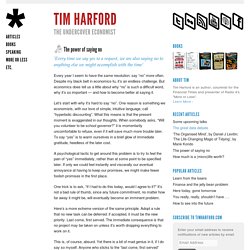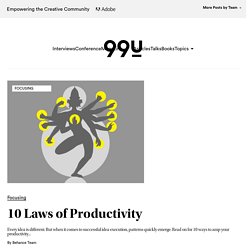

The power of saying no. ‘Every time we say yes to a request, we are also saying no to anything else we might accomplish with the time’ Every year I seem to have the same resolution: say “no” more often.

Despite my black belt in economics-fu, it’s an endless challenge. But economics does tell us a little about why “no” is such a difficult word, why it’s so important — and how to become better at saying it. Let’s start with why it’s hard to say “no”. One reason is something we economists, with our love of simple, intuitive language, call “hyperbolic discounting”. A psychological tactic to get around this problem is to try to feel the pain of “yes” immediately, rather than at some point to be specified later. The power of saying no. 8 Things Everybody Ought to Know About Concentrating.
“Music helps me concentrate,” Mike said to me glancing briefly over his shoulder.

Mike was in his room writing a paper for his U.S. History class. On his desk next to his computer sat crunched Red Bulls, empty Gatorade bottles, some extra pocket change and scattered pieces of paper. In the pocket of his sweat pants rested a blaring iPod with a chord that dangled near the floor, almost touching against his Adidas sandals. On his computer sat even more stray objects than his surrounding environment. Mike made a shift about every thirty seconds between all of the above. Do you know a person like this? The Science Behind Concentration.
Time Management Tips: How to Find the Right Mindset to Succeed With Time Management. For the past several years I have worked with time management techniques such as lists, prioritization, planning and so on.

But it wasn’t until I adopted a Quadrant 2 mindset that I really started seeing results. 17 Small Productivity Habits. The Mini-Habit The idea behind mini habits is that you can get to a larger habit if you start small, create simple goals, and aim for consistency.

In his book Mini Habits: Small Habits, Bigger Results, Stephen Guise gives the example of “The One Pushup Challenge.” He was doing what a lot of us do. Feeling guilty about not working out, he tried to fit years worth of exercise into the first workout which created an all or nothing attitude (not to mention a focus on goals and not process.) Well, one day he decided to do the opposite. In Habit Stacking: 97 Small Life Changes That Take Five Minutes or Less, author S. The core idea behind the mini-habits concept is that you can build a major habit by thinking small enough to get started. Habit-Stacking The purpose of habit-stacking is to create simple and repeatable routines (managed by a checklist). According to Scott there are 8 Elements of a habit-stacking routine. 17 Small Productivity Habits #1 Drink a Large Glass of Water #2. . #3. . #4. . #5. The Daily Routines of Geniuses - HBR.
Juan Ponce de León spent his life searching for the fountain of youth.

I have spent mine searching for the ideal daily routine. But as years of color-coded paper calendars have given way to cloud-based scheduling apps, routine has continued to elude me; each day is a new day, as unpredictable as a ride on a rodeo bull and over seemingly as quickly. Naturally, I was fascinated by the recent book, Daily Rituals: How Artists Work. Author Mason Curry examines the schedules of 161 painters, writers, and composers, as well as philosophers, scientists, and other exceptional thinkers.
As I read, I became convinced that for these geniuses, a routine was more than a luxury — it was essential to their work. 10 Laws of Productivity. You might think that creatives as diverse as Internet entrepreneur Jack Dorsey, industrial design firm Studio 7.5, and bestselling Japanese novelist Haruki Murakami would have little in common.

In fact, the tenets that guide how they – and exceptionally productive creatives across the board – make ideas happen are incredibly similar. Here are 10 laws of productivity we’ve consistently observed among serial idea executors: 1. Break the seal of hesitation. A bias toward action is the most common trait we’ve found across the hundreds of creative professionals and entrepreneurs we’ve interviewed. 2. When our ideas are still in our head, we tend to think big, blue sky concepts. Lgbt history. Gay rights in the US, state by state. International Gay and Lesbian Human Rights Commission.
TGEU - make human rights work. International Lesbian, Gay, Bisexual, Transgender, Queer Youth and Student Organization. Home / ilga - ILGA Europe. Coucil of Europe - LGBT. Welcome to the ECSOL Homepage! LGBT.